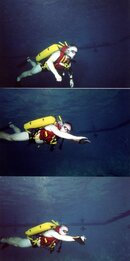fjpatrum, I was not trying to insult you when I mentioned your qty of dives. It is just surprising your opinions are so strong given the limited amount of dive experience you have. People generally form opinions based on their experiences.
You've repeatedly mentioned the large majority of scuba divers have no interest in speed. With only 50 dives, you have not dove with many divers. Why do people buy new fins ? Scubadiving Magazine fin speed tests articles were very popular. They were repeated for years and had an impact on the popularity of split fins and full foot fins.
When you read the fin section on scubaboard don't you see people mentioning power, performance or speed in the fin threads ?
On a dive boat, I hear people talking about how much they like their new fins, how they are faster than their old fins. I hear this type of conversation frequently because many divers like to discuss their gear.
I am not saying my opinion is automatically correct because I have more dives than you, but my experience with the divers I meet on dive boats is there are plenty of people interested in more speed. I like to dive in different locations. Been to many different tropical locations. The conversation is common.
You've repeatedly mentioned the large majority of scuba divers have no interest in speed. With only 50 dives, you have not dove with many divers. Why do people buy new fins ? Scubadiving Magazine fin speed tests articles were very popular. They were repeated for years and had an impact on the popularity of split fins and full foot fins.
When you read the fin section on scubaboard don't you see people mentioning power, performance or speed in the fin threads ?
On a dive boat, I hear people talking about how much they like their new fins, how they are faster than their old fins. I hear this type of conversation frequently because many divers like to discuss their gear.
I am not saying my opinion is automatically correct because I have more dives than you, but my experience with the divers I meet on dive boats is there are plenty of people interested in more speed. I like to dive in different locations. Been to many different tropical locations. The conversation is common.
Last edited:





